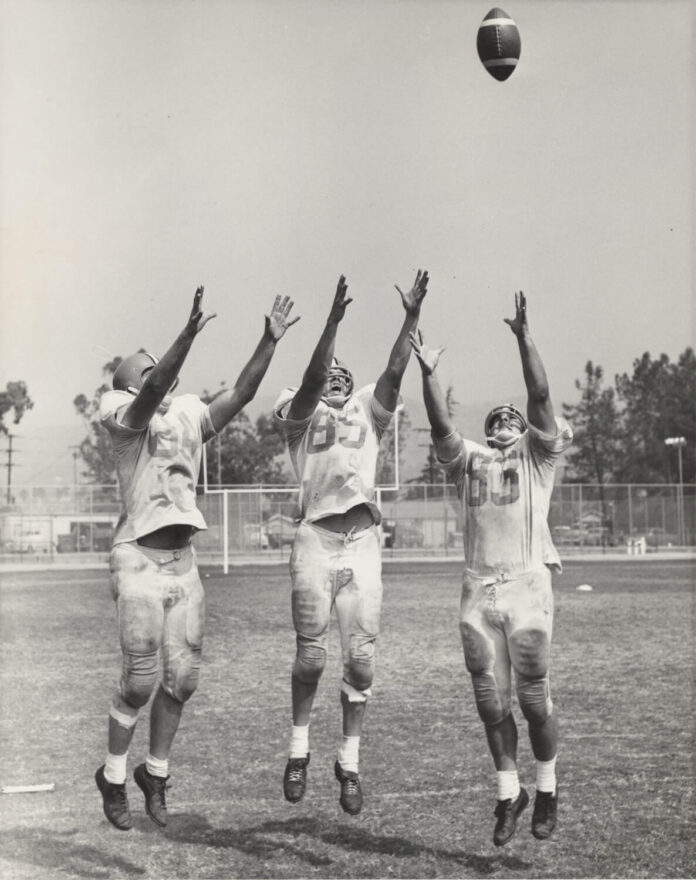Sitting at a table near the Tiger Cooler, Marcus Garrett ’93 taps on a pinned group chat in his messages app and swipes through its members, all former coaches or fellow players on Occidental’s football team between 1989 and 1992. There’s Michael “Lopes” Lopez and Brian “B-Mad” Madlangbayan, groomsman and best man at Garrett’s wedding, respectively. Among the others are Charles “C.J.” Jordan, Joe Smith, Kansas City Chiefs tight ends coach Tom Melvin and Dale Widolff, another groomsman and the head coach of Oxy football from 1982–2011.
“All the guys that I still talk to today are football guys,” Garrett said. “Dale being one of them.”
Garrett said he grew up in La Habra, California, with a single mother who was making $14,000 a year when he graduated high school. Garrett said that after being admitted to UC Berkeley and UCLA, he chose to attend Occidental because of football and their intentional provision of need-based financial aid. Like all schools who compete at the Division III level, Occidental does not offer athletic-based scholarships, but Garrett said that many former football players received significant non-athletic financial aid.
“There are a lot of us that were not full-pay kids [who] played football. Just what it was,” Garrett said. “And not just students of color. Probably half the dudes on that list I just showed you are guys who had a crap load of financial aid.”
In October 2020, President Harry Elam, backed by the Board of Trustees, announced the football program was discontinued. This decision was made after years of deliberation on whether to end the once elite institution at Occidental.
Occidental football played its first game in 1894. That same year, Oxy kicked off one of the 10 oldest rivalries in college football with a 16-0 win against Pomona. In 1929, Occidental played to a crowd of 20,000 against the University of Arizona in the first illuminated night game at the Rose Bowl, and 20 years later defeated Colorado A&M (now Colorado State) 21-20 in the 1949 Raisin Bowl, in front of 10,000 spectators.
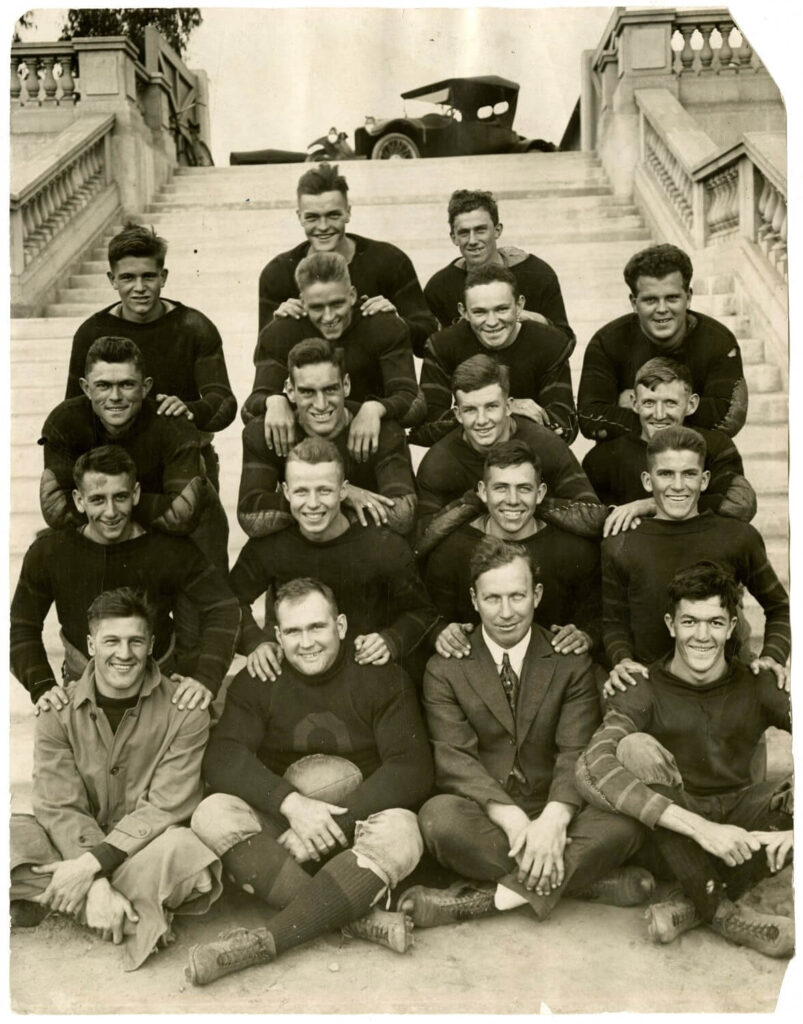
In the years that followed, a number of alumni made it into the professional ranks, including AFL champion Jack Kemp ’57, 1987 NFL coach of the year Jim Mora ’57 and five-year NFL running back Vance Mueller ’86. As a freshman in Fall 1982, Mueller had his first moments in the limelight — three, to be precise — one for each of the touchdowns he scored in Occidental’s 34-20 victory over the University of San Diego. The game was broadcast nationally on 60 percent of CBS affiliates due to an NFL strike and an NCAA loophole that let Division III teams like Occidental play on Sundays, when DI and DII teams could not.
The program enjoyed 11 SCIAC titles under Widolff’s tenure in the 1980’s and 2000’s, bifurcated by a rebuilding period in the mid-to-late 1990’s. Occidental won its last SCIAC championship in 2008. Widolff was fired in Spring 2012 for alleged recruiting violations. According to a February 2013 press release, the NCAA Division III Committee on Infractions penalized Occidental with, among other things, two years probation for failing to monitor its women’s volleyball program and Widolff’s improper contact of “467 current football student-athletes to request they consider transferring to Occidental.”
Widolff said that the College’s administration had the right to fire him.
“I’m not going to argue that point,” Widolff said. “The point I would make is I think they made a series of mistakes after they let me go. And it wasn’t just the football coaches making mistakes, I really do think there was a failure of leadership and the administration.”
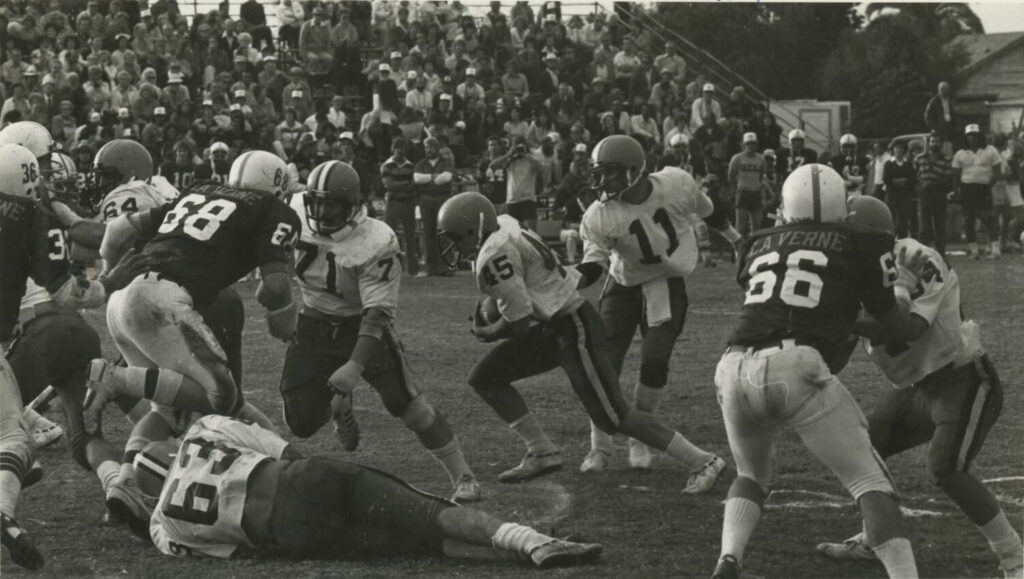
Bill “The Falcon” Redell ’64 came out of retirement and led the team during the 2012 season, before Doug Semones’ hiring in 2013. Semones’ retirement in July 2017, three weeks prior to training camp, left his replacement Rob Cushman with 38 days to prepare the team for the Fall campaign. The team’s roster, between 70-75 players under Widolff’s tenure, dropped to 47, and continued to shrink due to injuries once the season began. After canceling two of the season’s first five games, the college canceled the remainder of the 2017 season.
Vice President for Student Affairs and Dean of Students Rob Flot said that he was very involved in the cancellation of the 2017 season.
“The reason we ended the season was because our roster had winnowed to about 30 players, and I think six of them were quarterbacks,” Flot said. “We had people playing both sides of the line, we were extremely worried about injuries and just the ability to sustain the season. The roster was depleted.”
Following the demise of the 2017 season, former President Jonathan Veitch established a 16-member task force to determine football’s future at the college. Flot said that he was a member of the task force, composed of fellow senior administrators, athletic staff, football alumni, students, faculty and trustees.
“We had experts talk about concussions, we had data pulled from all the SCIAC schools, in terms of expenditures per sport — all sports, football in particular, but really all sports — rosters sizes; it was a lengthy process,” Flot said.
According to campus news reports on football, the task force, proposing its findings to the Board of Trustees in January 2018, recommended that Occidental “continue to support a safe and competitive football program.” At the core of the task force’s recommendation “were its conclusions regarding recruiting and fundraising, two key areas that will impact the short- and long-term success of the program.”
Safety would stem from a robust recruiting class, and the task force concluded that an adequate roster size of 55 would be achievable in time for the 2018 season. In college athletics, being competitive goes hand in hand with being well-funded. Mueller, a task force member, expressed his confidence in immediate financial support from alumni. By late April, Mueller had cobbled together more than $970,000 towards a $1.14 million goal from football alumni to support the team over four years. On April 23, 2018, Veitch announced that football would play on.
Occidental football never won another game, going 0-8 in both the 2018 and 2019 seasons.
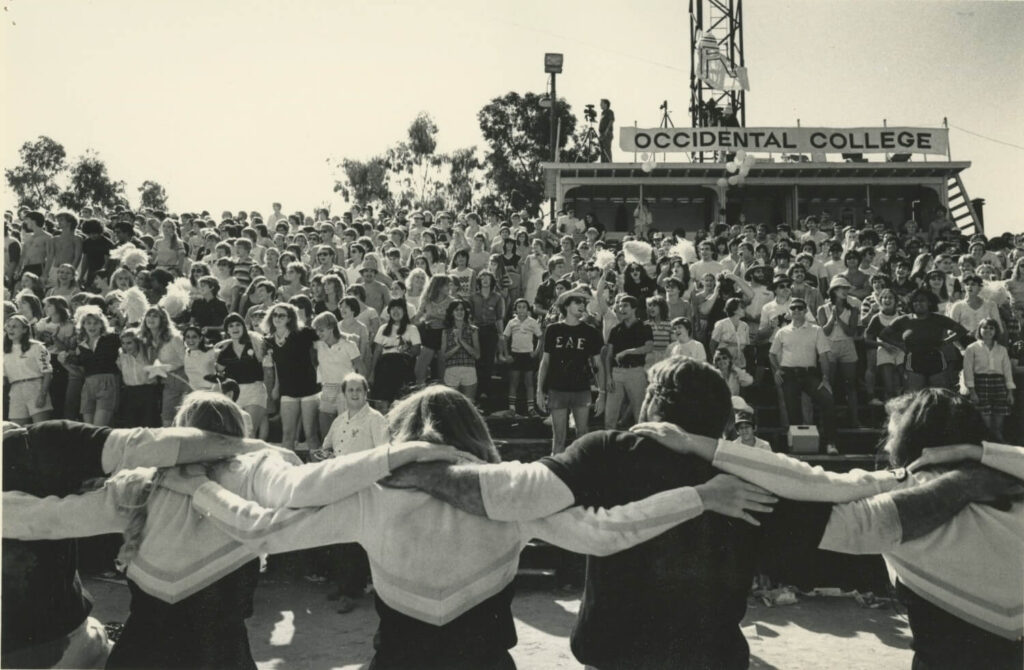
Elam, with the backing of the Board of Trustees, announced Oct. 13, 2020, that football would be discontinued in light of the substantial financial impact of the COVID-19 pandemic and the unique challenges specific to Occidental football.
Occidental football was stuck in the SCIAC’s no man’s land. Flot said football program was caught between the more prestigious athletic programs in the conference, and the programs with lower academic admissions requirements.
Veitch said schools in the conference who rank lower academically than Occidental depend on football and athletics more to recruit students, while more elite institutions have more money to put towards their programs.
Widolff said, “[Occidental’s] been in this window for decades. So, all of a sudden that’s a hurdle that needs to be overcome?”
In the discontinuation news release, Elam stressed that Occidental remains committed to athletics. Flot said the money saved from football was returned to the college’s general fund, with no stipulation that any of the roughly $450,000 football budget remain in athletics. Football’s total expenses totaled $454,985 in 2019.
Mueller said the pandemic obviously played a role in football’s termination, but that when it was cut, football had about $1.3 million committed to helping sustain the team over four seasons, from 2018–2021.
“Everything got cut short before the final conclusion, so I think that’s one of the things for myself and everybody who worked so hard on this campaign — folks sort of got the rug pulled out from underneath them before we had a chance to fully get it to where it needed to be,” Mueller said. “And yeah, there were struggles with the program — the year they canceled the season they were short on players. But it’s like anything, you reap what you sow.”
Veitch said before the program’s termination, there was speculation that ending football would leave a hole in the social fabric of the institution, but he didn’t think that during his tenure as president it was a big deal to begin with.
“There’s a kind of interesting way in which football lost its centrality,” Veitch said.
Flot said that when the program was cut, there was a reaction from alumni and parents, but the college’s administration heard from surprisingly few students.
“Athletics is not central to the identity of many of our students, nor is it a factor that causes students, other than student athletes probably, to come to Oxy,” Flot said.
According to Associate Dean of Admission Jordan Brown ’13, the Admissions office has never engaged in a male, or any gender specific recruitment strategy.
Widolff said that he heavily recruited prospects from the LA Unified School District (LAUSD) and local areas during his tenure.
“If you’re recruiting 10 kids from Texas, you might get one of them,” Widolff said. “Where if you recruited 10 kids from LA you might get three of them.”
After graduating from LAUSD’s Locke High School in Watts, LA, Robert Lewis ’92 played football at Occidental from 1988–1991. Lewis was profiled by the LA Times his first year in an article about overcoming the social and ethnic differences between the college and Watts. In 1986, Locke’s 48.8 percent dropout rate was LAUSD’s highest. He said he would not have ended up at Occidental without football.
“I was literally a fish out of water,” Lewis said. “I didn’t connect with hardly anyone, not even the other Black students there, really. Because I found [that] a lot of Black students there were still from at least middle income, middle-class backgrounds, or had attended maybe private schools or better schools, and I was not that.”
Lewis was one of three students to score over 1000 on the SAT his senior year at Locke, according to the LA Times profile.
“I remember getting there, and a common conversation freshman will have [is], ‘Oh, well, how’d you do on the SAT?’ And I remember telling a couple people my score and I remember their response was kind of like, ‘Aw, dude, what happened?’” Lewis said. “I remember thinking like, ‘Oh, I guess I didn’t do so well’. So when people would ask me from that point forward I would downplay it, say ‘Oh, yeah, I didn’t do too well, I only got a such-and-such.’ It just goes to show how the academic environment was so different. We use terms today like culturally competent, culturally congruent, culturally sensitive and all, and that was not Occidental, not at all.”
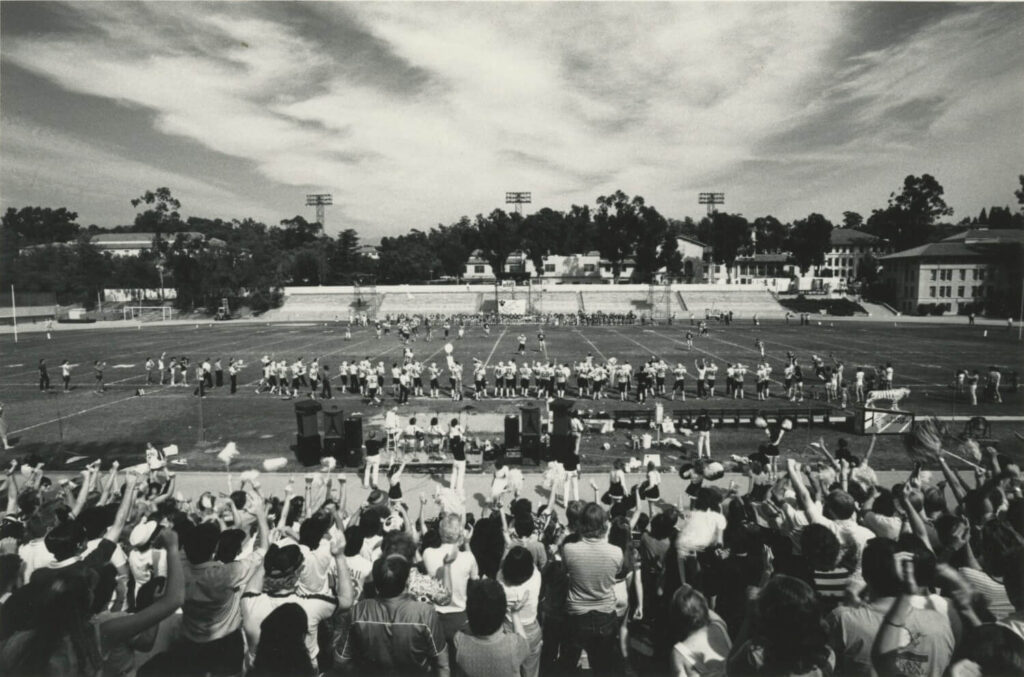
Russell Dinkins found himself spearheading efforts to save multiple track programs during the COVID-19 pandemic after writing an article bringing to light the racial implications of Brown University’s decision to cut their men’s track and field team. Dinkins, an Ivy League track and field champion, said that the majority of Black athletes in the NCAA play football and basketball. Besides those two, the only non-revenue sport that has a high percentage of Black athletes is track and field.
“There’s certain sports where you’re just like, it’s just not going to be diverse because there’s no diversity in the pipeline,” Dinkins said. In fact, Brown was cutting track and field while promoting sailing.
According to the NCAA, 10 percent of DIII student athletes in 2021-22 were Black, compared to 16 percent at the DI and DII levels. In 2022, 23 percent of DIII football athletes were Black. While not mutually exclusive, Dinkins said that eliminating opportunities that have been used by racial minorities to go to college also diminishes pathways for people from lower incomes.
“I imagine your school may not be capturing — even amongst the white population — […] the socioeconomic diversity that it used to capture by way of the sports teams now that the football team isn’t there,” Dinkins said.
Professor Victoria Jackson, a PAC-12 track champion in the 5,000 meters, is a professor of sports history at Arizona State University. After the Supreme Court’s decision on affirmative action earlier this year, Jackson said that universities will have to cast a wider net to give disadvantaged students financial aid.
“I’ve heard people saying, ‘Sport is the way we can keep our student body diverse now if we can’t explicitly be [using race-conscious admissions],'” Jackson said. “And that’s kind of problematic too, right? And it should be obvious to people who work in higher education that that’s a problematic approach. You shouldn’t have to be an athlete to gain access to this space.”
According to Dinkins, even if a majority of college athletes tend to come from more comfortable backgrounds, it is important for college administrators to know that sports, particularly track, basketball and football, are pathways for life opportunities.
“I do want people to just take a moment to appreciate the important role that athletics can play in providing those sort of educational pathways,” Dinkins said. “And I always say educational pathways because it’s not even about sport, it’s about the educational opportunity that’s offered through the vehicle that is college athletics.”
Flot, who ran DI track and whose son was a track athlete at Occidental, said that in his 15 years as a dean, the discontinuation of football was one of the hardest decisions he’s ever made.
“It was an incredibly difficult decision, one of the most difficult decisions in my professional career, and that’s the truth,” Flot said. “And making a hard decision is never easy, but we made the decision we felt we needed to at the time.”
Mueller said that he and other alumni have gotten to know Elam, and “feel that he’s been pretty straightforward” about football, and is certainly not a sports hater.
“I think the overall direction of the school was just kind of changing with their dedication more to trying to become more into the arts and the film and those types of majors at the college,” Mueller said.
If you stumble into Jack Kemp Stadium on a typical fall Tuesday night, during football season, you’ll find that the lights are still on. Patterson Field is alive with the men’s Ultimate Frisbee and Womxn’s rugby teams splitting the turf. At each end the goalposts still stand, a reminder of who else used to play here.
Contact James Miller at jmiller4@oxy.edu
![]()



































